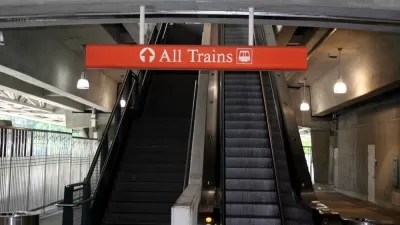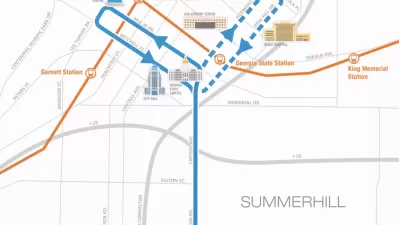Light rail on the Clifton Corridor was once a centerpiece of a $2.7 billion, 40-year transit expansion plans funded by a voter-approved sales tax. Now MARTA is considering using bus rapid transit on the corridor instead.

The Metropolitan Atlanta Rapid Transit Authority (MARTA) is reconsidering its plans to add light rail transit along the Clifton Corridor between Emory University, the Lindbergh Station, and the Centers for Disease Control, announcing that it's now studying bus rapid transit (BRT) for the corridor. The BRT plans for the corridor are the latest sign that MARTA is backtracking from the details of plans announced in late 2018 to expand the city's light rail system, using sales tax revenues approved by voters in 2016.
In an article for the Atlanta Journal Constitution, David Wickert reports that MARTA plans to select a preferred alternative for the Clifton Corridor by October, according to a report from interim CEO Collie Greenwood to the Atlanta City Council transportation committee in March.
MARTA's sudden attention to BRT on the Clifton Corridor is the latest evidence of a trend, reports Wickert: "In February, MARTA announced it would recommend bus rapid transit instead of light rail for the Campbellton Road line in southwest Atlanta. And a recent preliminary report on a section of the Atlanta Beltline found light rail would cost far more than expected."
The original plan also included plans for 13 miles of bus rapid transit lanes in addition to 29 miles of new light rail. As mentioned by Wickert, MARTA is already making progress on the BRT. "MARTA already is preparing to build the region’s first bus rapid transit line along Hank Aaron Drive and Capitol Avenue in Atlanta."
Officials from Emory University (the university has supported the proposed transit along the Clifton Corridor in the past) are quoted in the article saying they support either BRT or light rail for the corridor.
FULL STORY: MARTA considers rapid buses for Atlanta’s Clifton Corridor

Trump Administration Could Effectively End Housing Voucher Program
Federal officials are eyeing major cuts to the Section 8 program that helps millions of low-income households pay rent.

Planetizen Federal Action Tracker
A weekly monitor of how Trump’s orders and actions are impacting planners and planning in America.

Ken Jennings Launches Transit Web Series
The Jeopardy champ wants you to ride public transit.

Rebuilding Smarter: How LA County Is Guiding Fire-Ravaged Communities Toward Resilience
Los Angeles County is leading a coordinated effort to help fire-impacted communities rebuild with resilience by providing recovery resources, promoting fire-wise design, and aligning reconstruction with broader sustainability and climate goals.

When Borders Blur: Regional Collaboration in Action
As regional challenges outgrow city boundaries, “When Borders Blur” explores how cross-jurisdictional collaboration can drive smarter, more resilient urban planning, sharing real-world lessons from thriving partnerships across North America.

Philadelphia Is Expanding its Network of Roundabouts
Roundabouts are widely shown to decrease traffic speed, reduce congestion, and improve efficiency.
Urban Design for Planners 1: Software Tools
This six-course series explores essential urban design concepts using open source software and equips planners with the tools they need to participate fully in the urban design process.
Planning for Universal Design
Learn the tools for implementing Universal Design in planning regulations.
Ada County Highway District
Clanton & Associates, Inc.
Jessamine County Fiscal Court
Institute for Housing and Urban Development Studies (IHS)
City of Grandview
Harvard GSD Executive Education
Toledo-Lucas County Plan Commissions
Salt Lake City
NYU Wagner Graduate School of Public Service





























